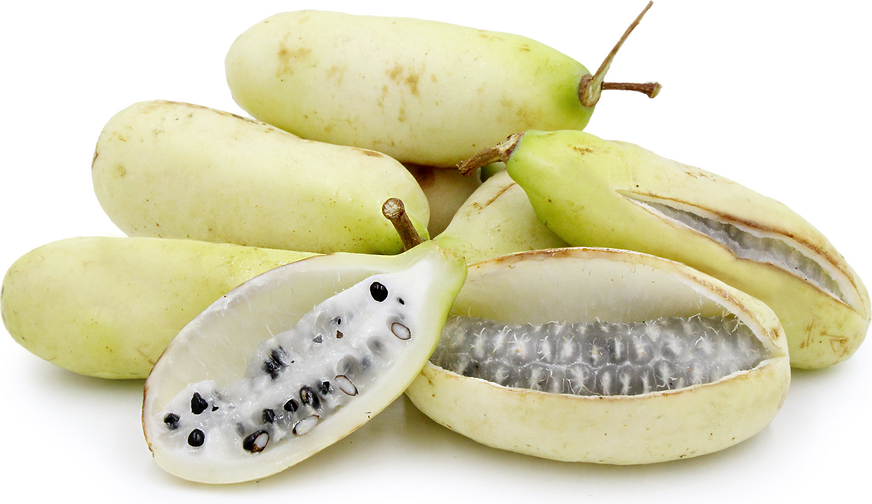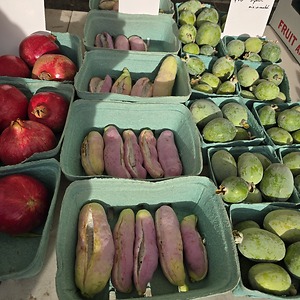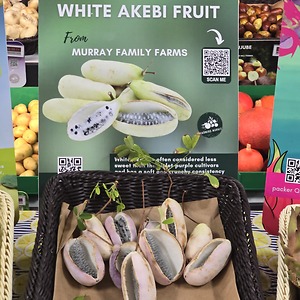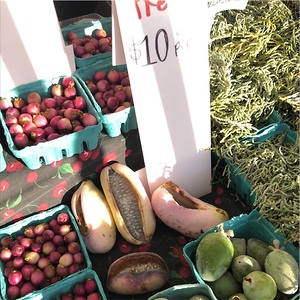


White Akebi Fruit
Estimated Inventory, lb : 0
This item was last sold on : 10/05/24
Description/Taste
White Akebi is a cylindrical to oblong fruit, averaging 5 to 10 centimeters in length, that delicately hangs from trailing vines. The skin ripens from green to white or ivory and is generally thick, spongy, and semi-firm with a soft give when squeezed. When ripe, the center of the fruit may crack and split open, revealing a translucent, gelatinous center that encases many small and edible, black-brown seeds. White Akebi is often considered less sweet than the violet-purple cultivars and has a soft and crunchy consistency with a neutral, subtly sweet and bitter flavor.
Seasons/Availability
White Akebi is available for a limited season in the early fall.
Current Facts
White Akebi, botanically classified as Akebia quinata, is a rare variety that belongs to the Lardizabalaceae family. The oblong fruits were first discovered growing wild in the forests in northern Japan and are also sometimes known as White Akebia and the White Chocolate vine, named after their strongly scented flowers. There are several other varieties of akebi appearing in brown, purple, grey, and violet hues with varying flavors and appearances, and in local markets, all the varieties may be found generally labeled as akebi. White Akebi is considered to be one of the rarer akebi varieties, and the sprawling vines are primarily grown as an ornamental. The fruits are also sometimes sold as specialty items in local Japanese markets and are promoted as an exotic gift for friends and family.
Nutritional Value
White Akebi is a good source of vitamin C, which is an antioxidant that can protect the body against environmental aggressors, boost the immune system, and provide anti-inflammatory properties. The fruit also contains zinc, vitamin B6, calcium, and potassium.
Applications
White Akebi is best suited for both raw and cooked applications such as frying, sautéing, or grilling. The fruit is entirely edible, and the flesh and seeds can be consumed straight, out-of-hand. It is important to note that the black-brown seeds are edible and can be swallowed, or they can be spit out and discarded depending on personal preference. Many Japanese also believe that the flesh has a bland flavor, so lemon juice is commonly added to help balance the sweetness and add complexity. Beyond fresh eating, White Akebi can be blended into drinks or smoothies, pickled in plum juice when young, or cooked into jellies and jams for added texture and flavor. The skin is also edible when cooked and is commonly sliced into pieces, breaded, and fried into tempura. In addition to frying, the skins can be stuffed with ground meat, miso, and vegetables, tied with a string, and then steamed for a soft, savory dish. The young stems and flower buds of the White Akebi plant can also be blanched and tossed into salads or lightly stir-fried as a crisp side dish. White Akebi pairs well with sake, meats such as ham, bacon, poultry, or fish, sesame oil, miso paste, shoyu or Japanese soy sauce, shiso leaf, noodles, rice, garlic, beans, spinach, and broccoli. The fresh fruits are highly perishable and should be used immediately when ripe for the best flavor. They can also be stored in the refrigerator for up to three days.
Ethnic/Cultural Info
Ripe akebi fruit is often a sign of the beginning of autumn for local villages in northern Japan. The fruits are only available for a couple of weeks at the start of fall and are considered a fresh treat for children while playing in the forests. Beyond being harvested from the wild, the vines are sometimes grown in home gardens and can be used as a culinary and ornamental plant. In some areas of Japan, White Akebi fruits are considered a delicacy and are given as gifts, carefully wrapped, and placed in ornate boxes. Rare fruits are a common gift given to friends and family as a sign of goodwill and friendship. Akebi fruits are also used in traditional medicines as an herbal diuretic the stems and fruits of the plant are believed to help reduce dampness within the body.
Geography/History
White Akebi fruit is native to the northern Tohoku region of Japan and is mainly cultivated in the Yamagata prefecture. The variety has been growing naturally since ancient times and has also spread to China and Korea. Outside of Asia, akebi fruits were introduced to Britain in 1845 and to the United States shortly thereafter. The vines were initially grown as an exotic ornamental variety in the western world, but due to the vigorous nature of akebi fruit vines, they have been deemed invasive by some environmental groups in the United States. Today White Akebi is considered to be very rare and can be found in limited quantities at specialty markets and grocers in Japan, China, and Korea. The fruits are also grown on a very small-scale across Europe, New Zealand, and in the United States.
Recipe Ideas
Recipes that include White Akebi Fruit. One
| Kudamononavi |
|
I Want to Know how to Eat Akebi |










